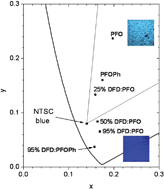Organic light emitting devices (OLEDs) containing a single blended layer of poly(9,9-dioctyl-2,7-fluorene) (PFO) or poly[9,9-bis(4-octyloxyphenyl)-2,7-fluorene] (PFOPh) and an electron transporting material 2,7-bis[2-(4-tert-butylphenyl)-1,3,4-oxadiazol-5-yl]-9,9-dihexylfluorene (DFD) have been fabricated. The long-wavelength emission (>480 nm) observed for pure PFO and PFOPh structures was reduced significantly and a pure blue emission, with Commission Internationale de l'Eclairage (CIE) colour coordinates (0.157, 0.037), could be achieved. The blended-layer devices also possessed considerably higher efficiencies than the pure PFO, pure PFOPh or the pure DFD structures. It is suggested that the presence of DFD results in an improved balance of charge carriers and provides a micro-encapsulation environment for the polymer chains, hindering the formation of fluorenone defects and their red-shifted emission.
You have access to this article
 Please wait while we load your content...
Something went wrong. Try again?
Please wait while we load your content...
Something went wrong. Try again?


 Please wait while we load your content...
Please wait while we load your content...